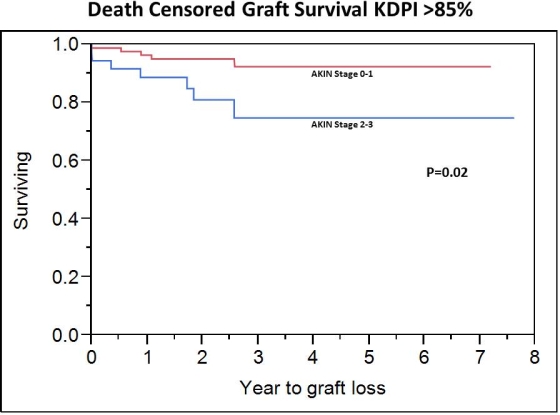Impact of Donor AKI on Outcome Following High KDPI Deceased Donor Kidney Transplantation.
1Transplant Surgery, Mayo Clinic Arizona, Phoenix, AZ
2Nephrology, Mayo Clinic Arizona, Phoenix, AZ
3Pathology, Mayo Clinic Arizona, Phoenix, AZ.
Meeting: 2016 American Transplant Congress
Abstract number: B185
Keywords: Donors, Graft survival, Kidney transplantation, marginal, Renal injury
Session Information
Session Name: Poster Session B: Kidney Transplantation: KDPI, HCV/Matching, Donor Age
Session Type: Poster Session
Date: Sunday, June 12, 2016
Session Time: 6:00pm-7:00pm
 Presentation Time: 6:00pm-7:00pm
Presentation Time: 6:00pm-7:00pm
Location: Halls C&D
Background: Transplanting deceased donor kidneys with AKI does not appear to have negative impact on graft survival, however the impact of AKI on high KDPI donor kidneys is not known. Our aim was to determine the impact of donor AKI on the outcome of high KDPI deceased donor kidney transplantation (DDKTx).
Material and Methods: We analyzed data on all patients who received a DDKTx at our institution from 1/2008 to 2/2015. We used data from DonorNet to stage all deceased donors using the AKIN classification. For this analysis, the high KDPI (>85%) cohort was divided into 2 groups; AKIN stage 0-1 and AKIN stage 2-3. Descriptive statistics and death censored graft survival analysis was performed
Results: 120 of the 815 DDKTx were high KDPI (>85%); 84 patients had AKIN stage 0-1 and 36 has AKIN stage 2-3. No significant differences were noted between groups with regard to basic demographics. Significant differences were noted in donor terminal creatinine, donor age and HLA mismatch although all other donor factors were well matched. No significant differences were noted in chronic changes at the time zero biopsy between groups.
The rate of DGF was higher in the AKIN stage 2-3 group but both groups had similar 1 year outcomes with regard to rejection, creatinine, and eGFR. However death censored graft survival was inferior for the high KDPI AKIN stage 2-3 grafts. There were 7 patients with graft loss in the high KDPI AKIN stage 2-3 cohort, 4 of which were within the first year. Causes of early graft failure include primary non-function (2), graft thrombosis and recurrent GN.
|
AKIN 0-1 (n=84) |
AKIN 2-3 (n=36) |
P Value | |
| DGF (%) | 46 | 83 | <0.0001 |
| Rejection 1st yr (%) | 17 | 11 | 0.42 |
| Cr 1 yr | 1.72±1.21 (n=61) | 1.67±0.94(n=23) | 0.85 |
| eGFR 1 yr | 43.9±16.9 | 45.7±18.5 | 0.66 |
| eGFR <30 1st yr (%) | 23 | 22 | 0.91 |

Conclusions: Transplanting high KDPI donor kidneys with added donor AKIN stage 2-3 is associated with inferior graft survival, suggesting that the high KDPI kidney may be more susceptible to long term injury from AKI.
CITATION INFORMATION: Haakinson D, Qaqish I, Smith M, Khamash H, Reddy K, Heilman R. Impact of Donor AKI on Outcome Following High KDPI Deceased Donor Kidney Transplantation. Am J Transplant. 2016;16 (suppl 3).
To cite this abstract in AMA style:
Haakinson D, Qaqish I, Smith M, Khamash H, Reddy K, Heilman R. Impact of Donor AKI on Outcome Following High KDPI Deceased Donor Kidney Transplantation. [abstract]. Am J Transplant. 2016; 16 (suppl 3). https://atcmeetingabstracts.com/abstract/impact-of-donor-aki-on-outcome-following-high-kdpi-deceased-donor-kidney-transplantation/. Accessed December 30, 2025.« Back to 2016 American Transplant Congress
